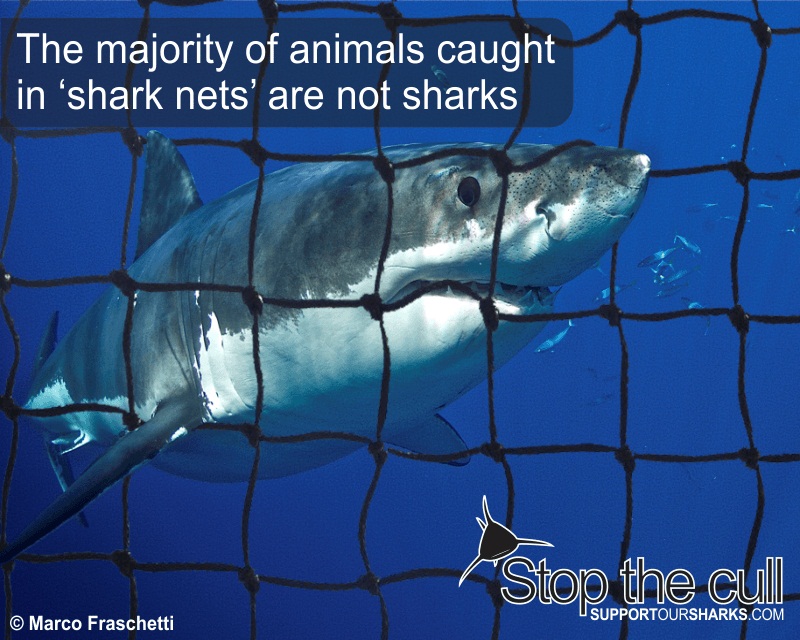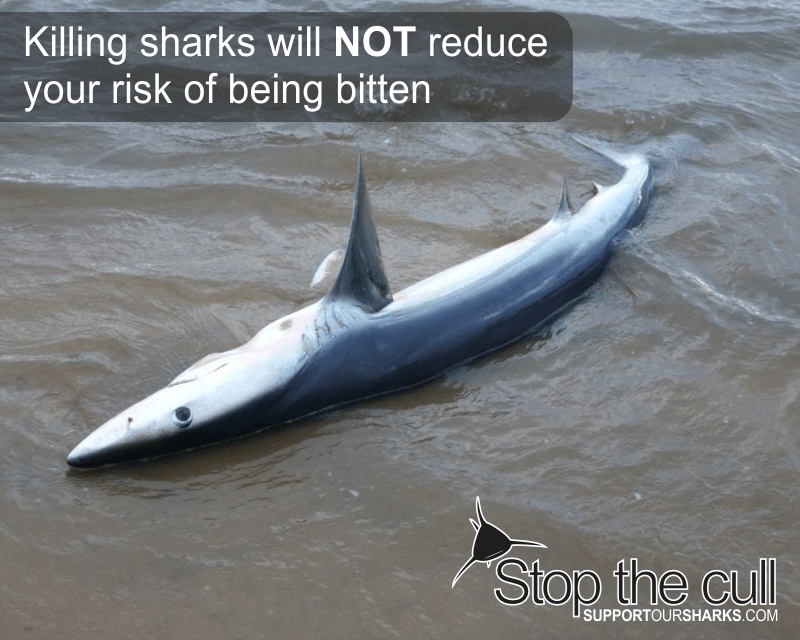A Case Study of Western Australia
Article by Support Our Sharks (29 November 2013)
Be sure to Like the Support Our Sharks Facebook page for more information.
 In light of the most
recent shark bite fatality in
Western Australia (WA) last week, there have been renewed calls for
a
cull of large sharks to protect
ocean users. Environment minister Greg Hunt has
said he wants to reduce the risk
of attacks. So what is the best way to reduce that risk?
In light of the most
recent shark bite fatality in
Western Australia (WA) last week, there have been renewed calls for
a
cull of large sharks to protect
ocean users. Environment minister Greg Hunt has
said he wants to reduce the risk
of attacks. So what is the best way to reduce that risk?
Are shark bites increasing?
There is no denying that each of these events is a tragedy and our
sympathy is, of course, with the family and friends of the victims.
However, based on statistical data, the number of shark related
fatalities is negligible when you consider the vast and increasing
number of swimmers entering our coastal waters every year.
Research has shown the number of
shark bite incidents occurring each year appears to be directly
related to the amount of time people spend in the sea. Given that
Western Australia has the
fastest population growth of any
Australian state, there is likely to be an increasing number of
people venturing out into our coastal waters every year. Thus, the
likelihood of someone encountering a shark increases and with it a
corresponding increase in shark bite incidents.
Politicians and the public are often quoted in the media saying shark
numbers in WA have increased. But most experts would agree that
there is no evidence to support such a statement.
Data gathered by Surf Life Savers WA has been used to suggest an increase
in the number of sharks in WA, by stating that
more sharks were sighted in
2012/13 (285 sharks) than in 2011/12 (247 sharks).
However, when you account for the number of hours that the helicopter
patrols were out looking for sharks (2012/13: 751 hrs; 2011/12: 620
hrs) we find that they sighted the same number of sharks per hour of
patrolling (approximately 1 shark every 2.5 hrs).
In fact,
research shows that the number
of attacks per million people in Australia almost halved from
approximately 60 per million people between 1930/1939 to
approximately 30 per million people between 2000/2009.
 Does culling work?
Does culling work?
So often the argument in favour of a cull comes down to the emotional
question of who is more important: a human or a shark. Rather, we
need to ask the question, will culling sharks actually reduce the
risk of an attack?
The answer is no. In fact, when shark culling was carried out in Hawaii,
between 1959 to 1976, over 4,500
sharks were killed and yet there was no significant decrease in the
number of shark bites recorded.
Culling has been the primary shark mitigation policy of the New South
Wales Government for over 60 years, through the use of
“shark” nets. But a report by
the
Department of Primary Industries
showed that 23 of the 139 (17%) attacks in the state, between 1937
and 2009, occurred at netted beaches.
Pre-emptively killing sharks is a response based on emotion rather than
of scientific data.
How to reduce personal risk
We take a calculated risk whenever we enter the ocean, but the risk is
quite small when compared to other daily activities. For example,
new research shows that rip
currents are the cause of an average 21 confirmed human fatalities
per year in Australia, compared with 7.5 for cyclones, 5.9 for
bushfires, 4.3 for floods, and 1 for sharks.
With the correct information, we can make an objective judgement as to
whether or not we accept the risk to enter the oceans.
The WA Department of Fisheries recently released a
report on how to reduce your
personal risk of being bitten by a shark (and you can find more
information at the
International Shark Attack File).
-
Stay out of the water if sharks have been sighted in the area.
-
Stay close to shore (within 30m of the water’s edge).
-
Don’t go in the water alone (stay in groups).
-
Avoid water temperatures lower than 22C.
-
Avoid water depths of greater than 5m when swimming or surfing.
-
Avoid swimming after heavy storms, or in low light conditions
(dusk and dawn).
-
Avoid swimming if there are seals, dolphins, whales or baitfish
nearby.
 What the government can do
What the government can do
The WA Government are in a difficult situation. They genuinely want to
protect ocean users, but at the same time they are well aware there
is no “magic bullet” to prevent shark attacks across the large
expanse of the WA coastline.
Their investment in monitoring and research has been a very positive step
towards reducing shark bite incidents in the region, but the use of
lethal control measures and the threats of a major cull of sharks is
not the answer.
Instead, we need to better understand exactly what causes sharks to bite
people, what factors are responsible for them venturing closer to
shore and more about their biology and life history. Recent research
has found, for example, that sharks'
diving behaviour is affected by
temperature and the moon, that female white sharks have
different movement patterns to
males, and that Australian white sharks have
home territories they always
return to.
This kind of research helps us better understand where sharks will be and
how they’re likely to behave. More of the same could help us develop
strategies to coexist with these important apex predators and
continue to enjoy the ocean safely.
The WA Government should also consider placing more emphasis on educating
people about the risks, such as the times of day and conditions
under which attacks are most likely to occur.
They could also put warning signs at beaches known to be frequented by
“dangerous” sharks. We are unaware of a single beach in WA that has
information boards related to the risks associated with encountering
potentially dangerous sharks. This strategy is common practice in
California and other places frequented by large sharks.
We will never completely prevent shark attacks, however, with better
education and improved investment in monitoring and research we can
reduce the risk and frequency of these tragic events.
More Information:
Check out our campaign pages to see what you can do to Stop The Cull.
-----------------------------------------------
Please share your thoughts about this article below.
Other Interesting Articles:
Disclaimer
Support Our Sharks posts articles and material
prepared by other organisations and individuals not affiliated with
Support Our Sharks for educational purposes. Support Our Sharks does not
necessarily agree with the opinions expressed in such material. Support
Our Sharks also provides links from this site to the websites of
featured news articles above for informational purposes only. The links
do not imply an endorsement by Support Our Sharks of these articles or
the content of their respective web pages.
